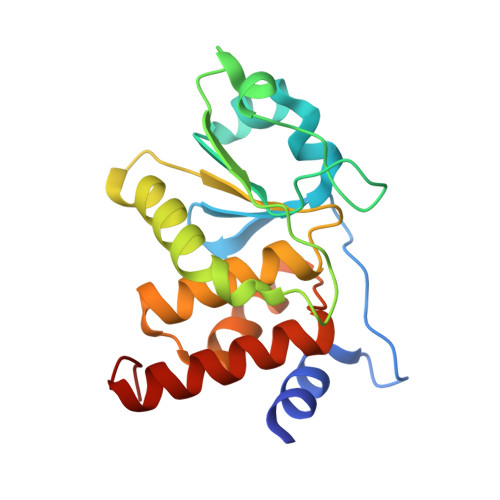Multidentate small-molecule inhibitors of vaccinia H1-related (VHR) phosphatase decrease proliferation of cervix cancer cells.
Wu, S., Vossius, S., Rahmouni, S., Miletic, A.V., Vang, T., Vazquez-Rodriguez, J., Cerignoli, F., Arimura, Y., Williams, S., Hayes, T., Moutschen, M., Vasile, S., Pellecchia, M., Mustelin, T., Tautz, L.(2009) J Med Chem 52: 6716-6723
- PubMed: 19888758
- DOI: https://doi.org/10.1021/jm901016k
- Primary Citation of Related Structures:
3F81 - PubMed Abstract:
Loss of VHR phosphatase causes cell cycle arrest in HeLa carcinoma cells, suggesting that VHR inhibition may be a useful approach to halt the growth of cancer cells. We recently reported that VHR is upregulated in several cervix cancer cell lines as well as in carcinomas of the uterine cervix. Here we report the development of multidentate small-molecule inhibitors of VHR that inhibit its enzymatic activity at nanomolar concentrations and exhibit antiproliferative effects on cervix cancer cells. Chemical library screening was used to identify hit compounds, which were further prioritized in profiling and kinetic experiments. SAR analysis was applied in the search for analogs with improved potency and selectivity, resulting in the discovery of novel inhibitors that are able to interact with both the phosphate-binding pocket and several distinct hydrophobic regions within VHR's active site. This multidentate binding mode was confirmed by X-ray crystallography. The inhibitors decreased the proliferation of cervix cancer cells, while growth of primary normal keratinocytes was not affected. These compounds may be a starting point to develop drugs for the treatment of cervical cancer.
Organizational Affiliation:
Infectious and Inflammatory Disease Center and Cancer Center, Burnham Institute for Medical Research, La Jolla, California 92037, USA.















